The short-term rental (STR) market isn’t what it was a few years ago. Growth has slowed, supply dynamics are shifting, and guest behavior continues to evolve.
In the latest episode of STR RevTalk, Jarne Vancompernolle (CPO, AutoRank and Otamiser) and I (Bart-Jan Leyts, CEO and Founder of Otamiser and AutoRank) sat down with Richard Cottrell (Head of Global Sales, Lighthouse) and Jasper Ribbers (Head of Revenue Management, Freewyld Foundry) to unpack these changes. Together, they explored what the current market data tells us, why owner alignment is more critical than ever and how to get your owners on board with fast changes in your revenue strategy.
Watch the full episode here.
.jpg)
Total bookings decline: a warning sign for property managers and revenue managers
The total number of bookings across U.S. regions has declined year-over-year, showing the growing volatility in the short-term rental market. The Southwest U.S. saw the sharpest drop at 8.79%, followed by the Mid-Atlantic States (-7.50%) and the Hawaiian Islands (-7.38%). Even the relatively stable Midwest U.S. wasn’t immune, with bookings down 1.39%.
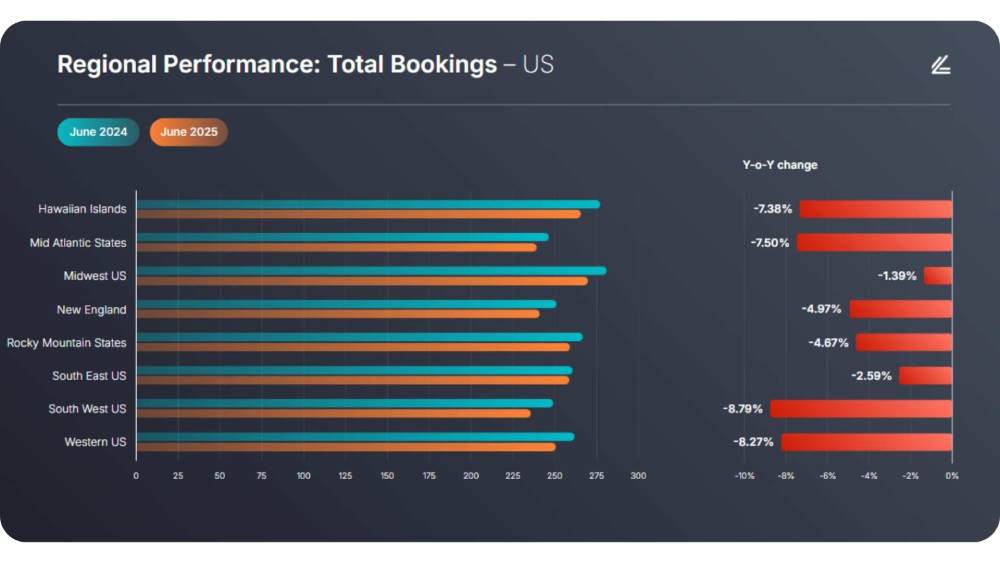
Economic uncertainty is reshaping travel habits
This decline is being driven by a combination of forces that are reshaping the short-term rental landscape in 2025. Economic uncertainty continues to weigh heavily on consumer behavior. With inflation eroding purchasing power, higher interest rates tightening household budgets, and whispers of a potential recession in the air, many travelers are becoming more cautious about discretionary spending.
STR regulations are changing the playing field
At the same time, growing short-term rental regulations are putting additional pressure on the market. In several key U.S. regions, stricter laws and restrictions, like New York City’s near-total restrictions on short-term rentals under Local Law 18, are reshaping the landscape. These measures, designed to balance local housing needs with tourism demands, are limiting inventory in some markets while altering guest patterns in others.
A more competitive and fragmented environment
Together, these factors have created a more fragmented and competitive environment. For property managers, this means every booking counts more than ever. It also underscores the need for agile, data-driven strategies that can quickly adapt to shifting demand patterns.
Supply dynamics across OTAs: Booking.com is gaining ground
The distribution landscape is shifting as OTAs pursue different strategies. Lighthouse data shows Airbnb’s U.S. supply grew by 2.48% in the U.S. despite the platform removing over 400,000 listings globally to improve quality control and regulatory compliance.
This suggests Airbnb is prioritizing quality listings that deliver consistent guest experiences, making it harder for underperforming properties to maintain visibility.
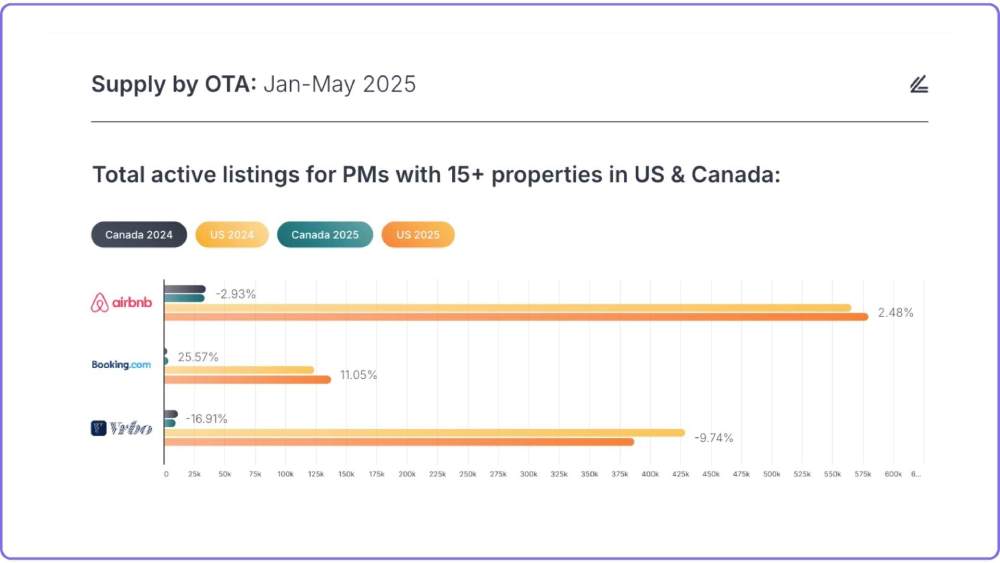
Meanwhile, Booking.com saw a 11.05% supply growth in the U.S., signaling aggressive efforts to expand their alternative accommodations inventory. Their focus on urban, high-ADR markets and host acquisition initiatives is paying off, positioning them as a more serious competitor to Airbnb than in previous years.
In stark contrast, VRBO experienced a 9.74% decline in active listings. This drop could be tied to market consolidation or a strategic deprioritization of certain regions, reflecting a shifting competitive landscape.
It’s important to note that these figures reflect active supply on the platforms, not the actual number of bookings being made. A growing supply doesn’t necessarily mean demand is keeping pace, it may lead to increased competition between listings, especially in oversaturated markets.
Occupancy trends highlight a softening market
Looking at regional occupancy rates, the picture is mixed but leans toward decline.
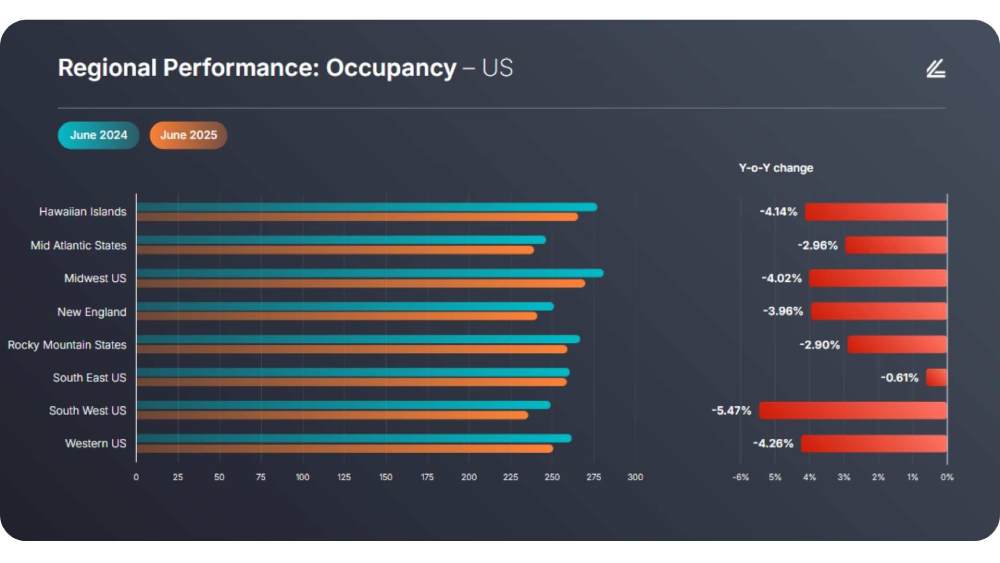
The Hawaiian Islands saw occupancy drop by 4.14%. This decline reflects multiple factors: rising flight and travel costs are making people take fewer long-distance trips, and international visitor recovery is going slowly. For property managers in Hawaii, this means focusing on longer booking windows and refining strategies to attract both domestic and international travelers.
The Southwest U.S. recorded the steepest occupancy decline at 5.47%, signaling challenges in markets traditionally reliant on seasonal domestic travel.
Average length of stay is increasing: what this means for strategy
While occupancy is softening, average length of stay (LOS) is increasing across most U.S. regions. For example, the Rocky Mountains saw a 3.82% year-over-year rise, and the Southeast U.S. increased by 2.85%.
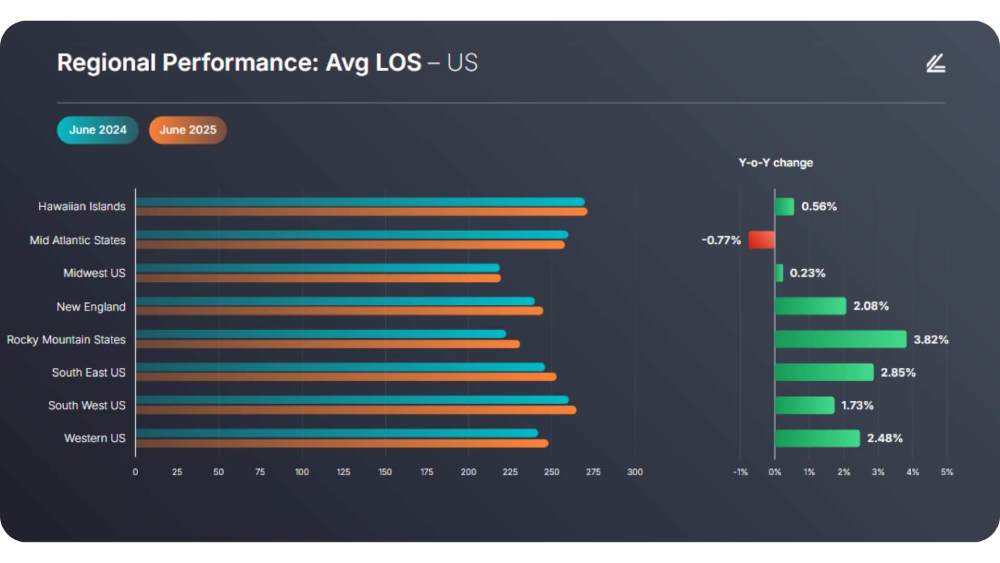
This shift is driven by several factors. Rising travel costs have led guests to take fewer trips but stay longer when they do. The growing “slow travel” movement among Millennials and Gen Z reflects a desire for more meaningful, immersive experiences. Additionally, blended work-and-leisure trips remain popular among digital nomads.
For property managers, this trend creates opportunities to adjust minimum night stays and offer discounts on longer bookings, increasing occupancy while reducing operational turnover costs.
ADR optimism and its hidden risks
Interestingly, despite softening occupancy and declining bookings, many property managers are forecasting higher ADRs for the next 365 days. Lighthouse’s analysis of the top 50 property managers shows widespread optimism about rate growth.
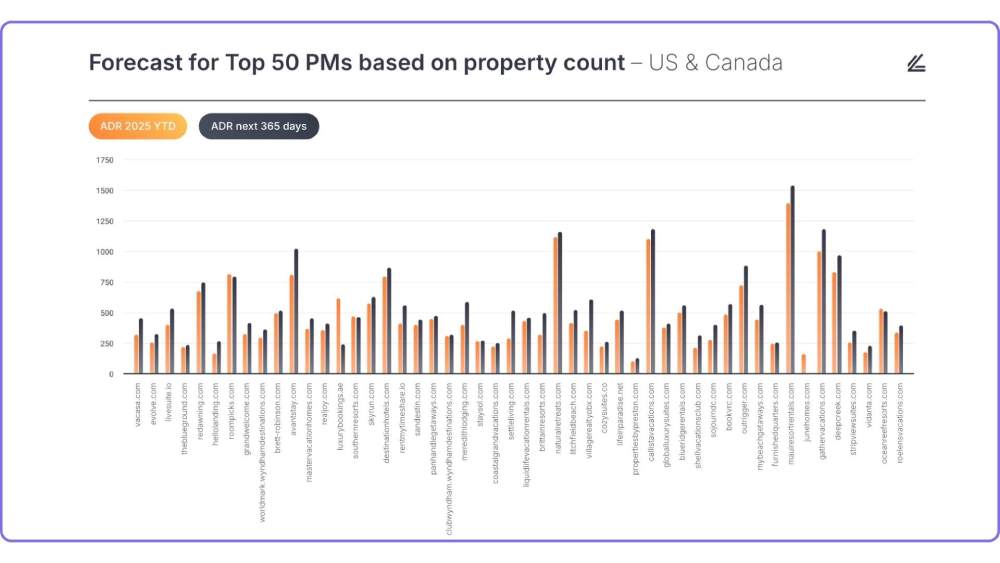
However, this confidence carries risks. Some operators may be overestimating demand elasticity and pricing themselves out of the market. Overly ambitious ADR targets without corresponding demand could lead to lower occupancy, stalled listings, and ultimately, missed revenue.
A balanced strategy, where ADR growth aligns with actual demand trends, is essential to sustain long-term profitability.
Owner alignment: the human side of vacation rental revenue management
The short-term rental landscape is more fragmented and volatile than ever. Shifting OTA dynamics, softening occupancy rates, and evolving guest behavior have made traditional approaches less effective. But even the best data-driven strategies can falter if property managers fail to align with owners.
Many owners have a deeply emotional connection to their properties. They often view them as personal investments, believing their unique décor or location justifies premium rates. This mindset can lead them to question pricing strategies, especially when comparing their bookings to neighboring listings without understanding broader market trends or OTA algorithms.
This emotional attachment creates tension: managers focus on long-term, data-driven revenue goals, while owners fixate on anecdotal evidence and expect immediate results.
Setting expectations from day one
To navigate these challenges, revenue management companies like Freewyld Foundry and Otamiser focus heavily on educating owners from the start. During onboarding, they make it clear that trusting the team’s expertise, even when certain decisions might not seem logical at first, is essential for long-term success. Owners are encouraged to step back from micromanaging day-to-day pricing and allow the revenue managers to work proactively.
This approach helps avoid the common pitfalls of overpricing, restrictive stay policies, or delayed adjustments, which can stall momentum and push a property into the dreaded “dead zone.” By setting these boundaries early and explaining the why behind each strategy, managers build the confidence needed to keep their portfolio performing optimally, even in challenging market conditions
Tailoring your approach to different owner types
No two owners are the same, and treating them as such can lead to unnecessary friction. Some are highly involved, tracking every booking and questioning each rate adjustment, while others prefer a hands-off approach and only want high-level updates on revenue performance. Then there are those who care deeply about occupancy, needing reassurance that their calendars remain full, and others who are laser-focused on ADR, often resisting strategies that involve rate adjustments to boost booking momentum.
Recognizing these differences early and adapting your communication style accordingly is a critical skill for revenue managers. For the occupancy-focused owner, it might mean sending regular pacing updates and explaining why certain dates remain open as part of a longer-term strategy. For the ADR-focused owner, the conversation might lean heavily on data, comparing their property’s performance to market benchmarks and demonstrating how a dynamic pricing strategy protects their revenue over time.
A/B testing as a tool for data-driven persuasion
A/B testing is a powerful tool for property managers. At Freewyld Foundry, Jasper Ribbers and his team have used this approach to bridge the gap between data-driven decision-making and owner perceptions.
In one example, they managed a portfolio of 20 nearly identical units in the same building. Faced with an owner who insisted on maintaining high minimum rates and restrictive policies, the team proposed a simple experiment: they would apply the owner’s rules to 10 units and have full pricing freedom with the other 10. Over the course of a month, they monitored performance closely, tracking occupancy, average daily rates, and total revenue.
The results were undeniable. The units where Freewyld had control outperformed the owner-restricted units by a staggering 30% in total revenue. This wasn’t just a marginal difference, it was a clear demonstration of how flexibility allows managers to respond to demand shifts, leverage OTA algorithms, and maintain momentum even in softer market conditions.
Eventually, this success helped earn the owner’s trust. Seeing the tangible revenue difference, the owner dropped their restrictions and gave the revenue management team full freedom to execute their strategy across all 20 units.
The hidden danger of “dead listings” and why momentum is everything
When owners impose rigid rules, like high minimum rates, long minimum stays, or a refusal to adjust pricing dynamically, they often believe they’re protecting their property’s value. In reality, these restrictions can have the opposite effect.
When a listing stagnates for three to six weeks, the platforms interpret the inactivity as a lack of demand. The result? Your property is pushed further down the rankings, overshadowed by competitors that are attracting consistent bookings. From there, recovery often requires steep discounts, aggressive marketing campaigns, and extra operational effort just to regain the momentum that was lost.
As Jasper Ribbers pointed out, in extreme cases, it might even be more cost-effective to rent out a few nights for free rather than letting the property sit empty for too long. Keeping bookings flowing, even at minimal or no profit, sends critical signals to the platforms’ algorithms that your property is in demand. This approach can help maintain your listing’s visibility and prevent the far greater revenue loss that comes with falling into the “dead zone.”
The 80/20 rule: choosing the right owners
In vacation rental revenue management, not every owner is a perfect fit, and recognizing this early can save property managers countless hours and headaches. While it’s tempting to take on every property that comes your way, especially when scaling a portfolio, the reality is that some owners can become roadblocks to success.
This is where the 80/20 rule comes into play. As Jasper Ribbers explained, “20% of owners can consume 80% of your time.” These are often the owners who resist professional advice, insist on micromanaging every pricing decision, or impose restrictions that compromise your ability to execute a dynamic, data-driven strategy. The emotional connection they have to their properties can lead to decisions based on personal preference rather than market realities, resulting in stalled listings, reduced visibility on OTAs, and ultimately lower revenue.
The holistic model: pricing, OTAs, and guest experience
Successful vacation rental revenue management in 2025 requires a holistic approach:
- Dynamic pricing aligned with market trends and owner goals
- OTA-specific strategies that consider each platform’s algorithm and booking window
- Listing optimization to ensure properties appear in filtered searches
- Guest experience excellence to drive five-star reviews and repeat bookings
As Richard summed up: “It’s not about pulling one lever, it’s about integrating pricing, distribution, and operations for compounding results.”
Want to see how AutoRank can help you build a holistic vacation rental revenue management strategy? Book a call today to discover how we combine expert oversight with powerful technology to maximize your portfolio’s performance.
AutoRank is the world leader in Airbnb listing optimisation.


.jpg)